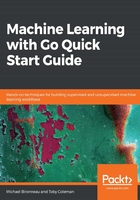
Integrating and deploying
The boundary between the ML model and the rest of the application must be defined. For example, will the algorithm expose a Predict method that provides a prediction for a given input sample? Will input data processing be required of the caller, or will the algorithm implementation perform it? Once this is defined, it is easier to follow best practice when it comes to testing or mocking the ML model to ensure correctness of the rest of the application. Separation of concerns is important for any application, but for ML applications where one component behaves like a black box, it is essential.
There are a number of possible deployment methods for ML applications. For Go applications, containerization is particularly simple as the compiled binary will have no dependencies (except in some very special cases, such as where bindings to deep learning libraries such as TensorFlow are required). Different cloud vendors also admit serverless deployments and have different continuous integration/continuous deployment (CI/CD) offerings. Part of the advantage of using a language such as Go is that the application can be deployed very flexibly making use of available tooling for traditional systems applications, and without resorting to a messy polyglot approach.
In Chapter 6, Deploying Machine Learning Applications, we will take a deep dive into topics such as deployment models, Platform as a Service (PaaS) versus Infrastructure as a Service (IaaS), and monitoring and alerting specific to ML applications, leveraging the tools built for the Go language.